by Phil Bergman
Description of Article
This article was written to give the reader more information about the rare type of plant known as the Variegated Lady Palm. There’s little information about them in reference books or on the Internet. I’ve tried to keep this easy to read and show a lot of photographs so you can learn about these amazing plants.
INTRODUCTION
In the United States, collecting of the dwarf variegated Rhapis varieties have always been an eclectic hobby by those few fanatics who developed a keen interest in these extremely rare plants. But in Asia and particularly Japan, collection and cultivation of these prized plants is a passion and a tradition. The history of these plants go back centuries. Dating back to the 1600’s, the cultivation of miniature green Rhapis has been recorded. The first mentions of variegated Rhapis in Japan dates back to the late 1700’s. These variegated plants were considered a prized possession and handed down from generation to generation. Interestingly, the habitat origins of these variegated plants is probably not in Japan but rather in China, Thailand or other Asian countries. But, somehow specimens made their way to Japan where enthusiasm for them grew.
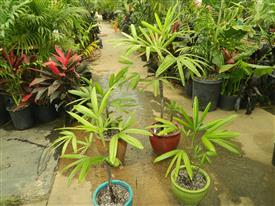
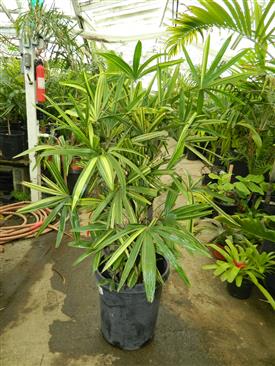
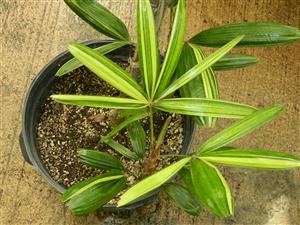
PATTERNS OF LEAFLET STRIPING ON VARIEGATED RHAPIS EXCELSA
The variegation of Rhapis palms is apparent only on the leaflets. When you look at pictures of these variegated types, close up photos are always of the leaflets. They have assorted shades of green (light or dark) adjacent to cream, yellow or white stripes. The variegation runs in an axial pattern along the length of the leaflets. This produces stripes of green adjacent to lighter stripes of yellow or cream colors. Differences of individual variegation is in the colors that are displayed, the number of stripes of color and the width of the stripes. Individual varieties/cultivars have been named based on the variegation pattern and colors.
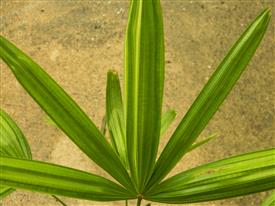
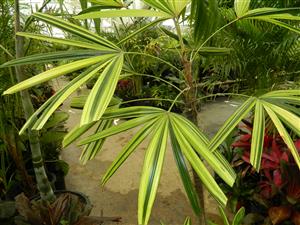
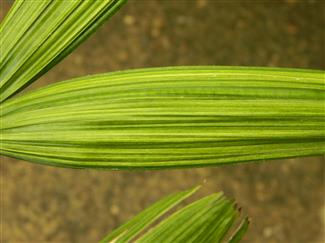

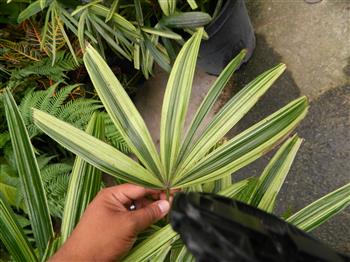
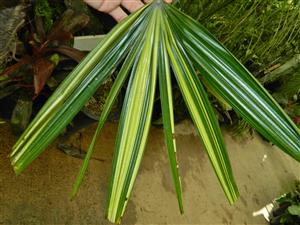
RARITY OF VARIEGATED RHAPIS
As I have been involved in the palm nursery business for about 39 years, historically I would only rarely come across a variegated Rhapis. Importation of plants really didn’t exist into the United States before 1970. Most imported plants would come from Japan. And, they were extremely expensive for any nursery here to purchase. Rhapis Gardens, a nursery owned by Lynn McKamey in Texas, was the only nursery I knew of back then that specialized in Rhapis and variegated cultivars. Unfortunately, it no longer exists although she still maintains her website. Presently at our nursery, the only way we come across these variegated Rhapis is when an enthusiast either sells his plant or divides it into multiple plants. Seeds are essentially never available.
Although variegated forms of other Rhapis species do exist, the majority of the variegated Rhapis are cultivars of Rhapis excelsa. Most of the latter never get more than four feet tall although some may reach six feet. These dwarf, slow growing plants are used on patios or inside a home or business office. Often they adorn an executive’s desk. As a consumer, one should expect a lengthy search just to find one of these gems. There are just not that many of them around. Growth is extremely slow but plants do well outdoors in Southern California, usually in a filtered light area of the garden or on a patio.


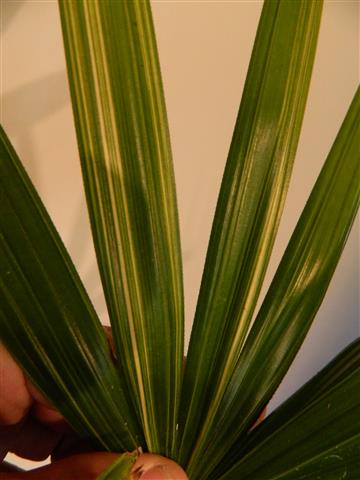
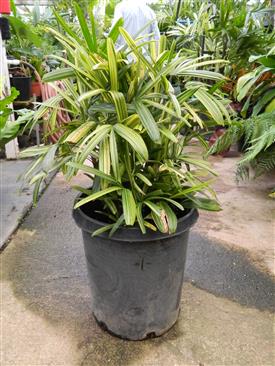
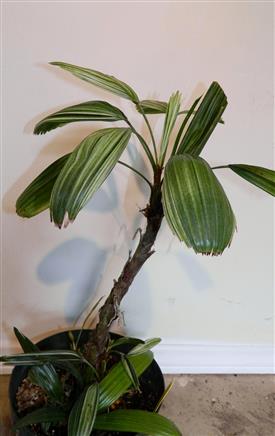
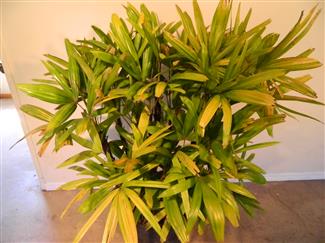
THE JAPANESE NAMES OF CULTIVARS
Cultivar or varietal names have traditionally been written in Japanese as enthusiasts there have for decades been hybridizing new varieties with special attention to leaf form and width, colored markings and overall appeal of the plant. Since the 1940’s in Japan there has been a formal registry for new cultivars developed by nurseries or enthusiasts. And, the most desirable plants have always been highly coveted. There are presently over a hundred different cultivars that are known to exist. But, I want to remind the reader that there is variability between plants of any given cultivar. Do not consider these named cultivars to always be a genetic match and all look the same. With all these cultivar names, usually in Japanese (actually or translated), the assumption is that plants of any given cultivar should all look the same. It is true that a division from a mature plant will give the progeny the same leaf and leaf coloration. But, if you come across plants of the same “cultivar” from different sources, they are rarely an exact match. I say this from my own experience. You’ll also find that, on a given plant, variegation also can vary from leaf to leaf.
In terms of the difference of the variegated cultivars of this species, you should watch for a few things. They are all either yellow stripes on a green leaf or what seem to be the reverse. These stripes run longitudinally along the leaflet axis. They never are perpendicular to that axis. What determines the cultivar are things such as the width of these stripes, the number of the stripes, stripe variation, the predominant leaflet color, the background leaf color and the variation is both the green and yellow colors. There are varieties where the entire leaflets are almost bleached out to a faint yellow or a near white color. I’ve found these types difficult to grow. And, there are some where the variegated stripes are tiny and almost not visible. Typically you’ll note yellow stripe width to be variable with a green background color of the leaflet between the stripes. Below are photographs of plants we acquired that came with a given cultivar name.
Rhapis excelsa chiyodazura

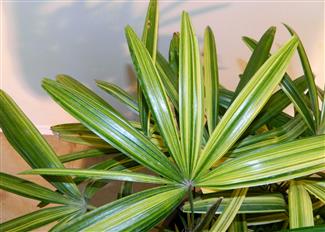
Rhapis excelsa zuikonishiki
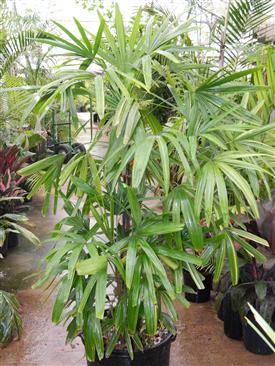
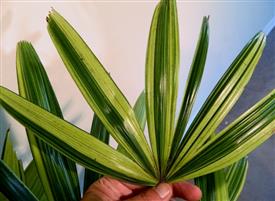
Rhapis excelsa goldilochs
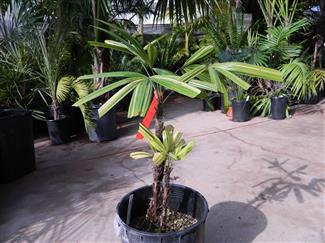
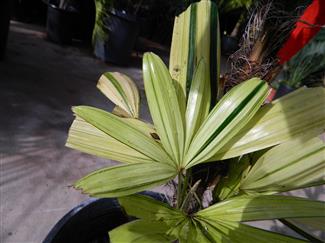
Rhapis excelsa ayanishiki
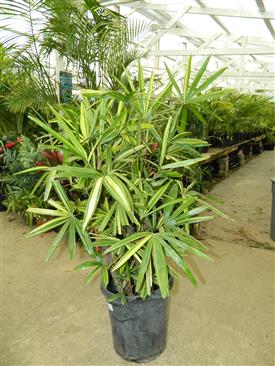
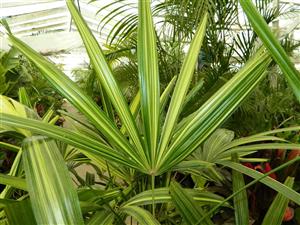
Rhapis excelsa toakainishiki
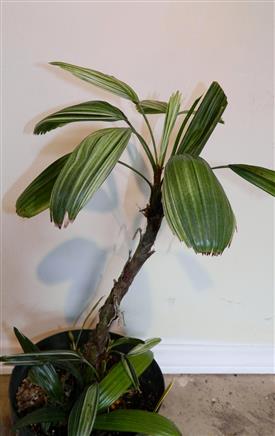

Rhapis kotobuki, variegated
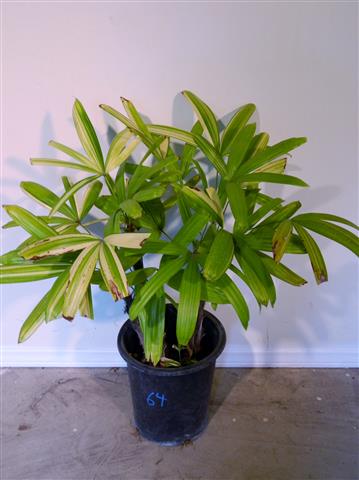
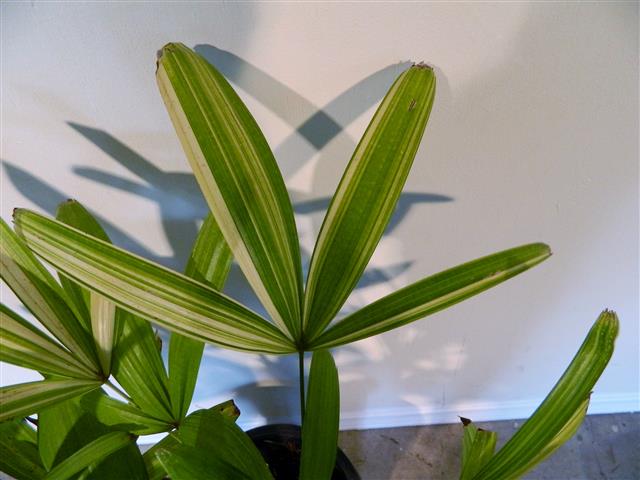
Rhapis excelsa suiko-lutido
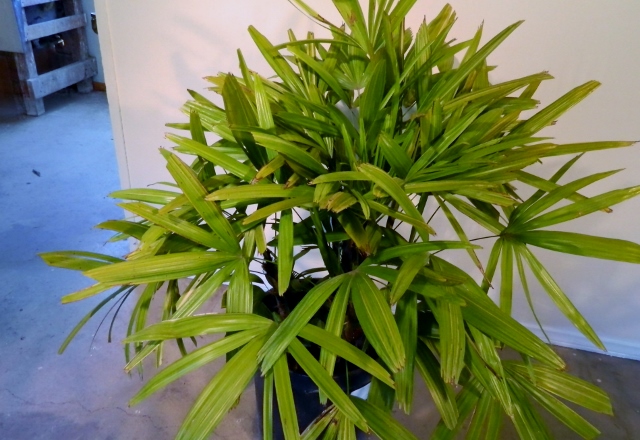

Rhapis excelsa zuikonishiki


Rhapis excelsa eisannishiki
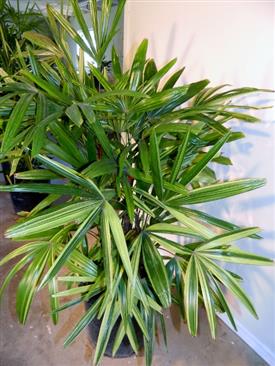
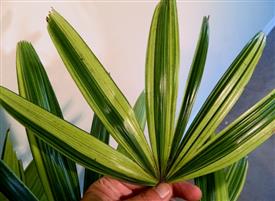
Rhapis excelsa zuikonishiki
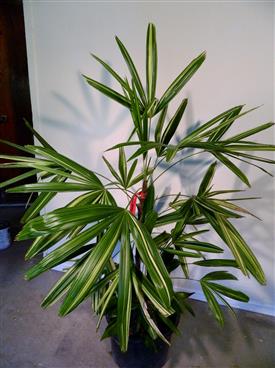
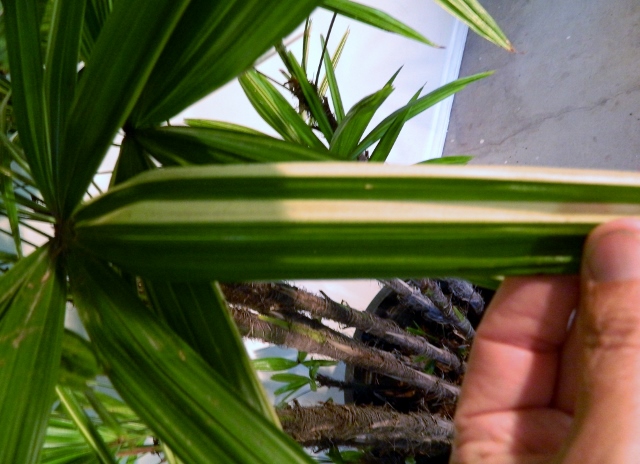
EXAMPLES VARIEGATED RHAPIS EXCELSA WITH NO CULTIVAR NAME
On many occasions you will see variegated Rhapis without a given Japanese or English cultivar name. In fact, this is probably the norm. I’d estimate this un-named yet variegated Lady Palm group will represent about 80% or more of the variegated Rhapis that one might find at a specialty nursery. This makes these plants no less desirable, valuable or collectible. What I’d advise an enthusiast to do is actually look at the plant in front of you. Is the plant attractive? Does it have nice variegation? Are the colors distinct and different? Look at the plant you are considering and decide, paying no attention to the plant’s label. It has to be appealing to you. In other words, buy plants that you really like and that show nice quality. Below are nursery plants that we’ve had at Jungle Music and these plants we just called “Variegated Rhapis excelsa“. All are very desirable. Over the past several years we’ve had dozens and dozens of plants that are just labeled as variegated without a cultivar name. Below are some examples.
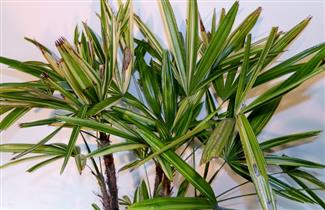
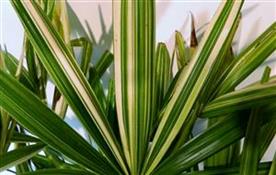

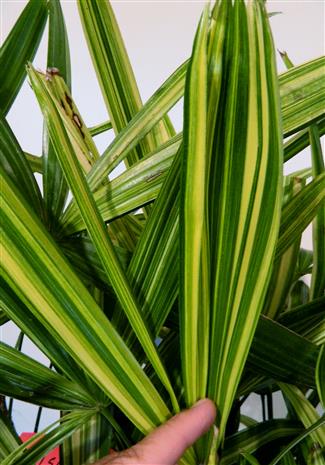
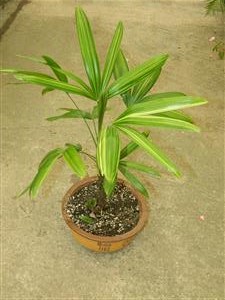
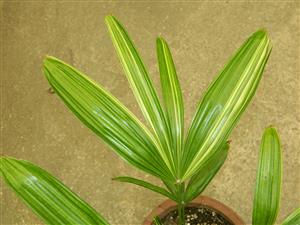
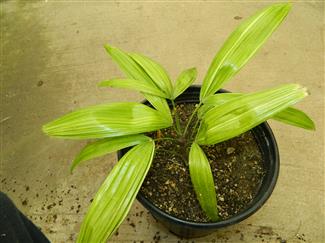
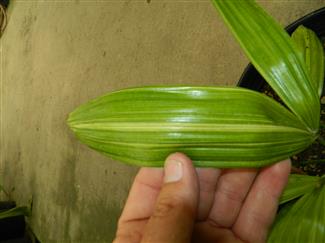
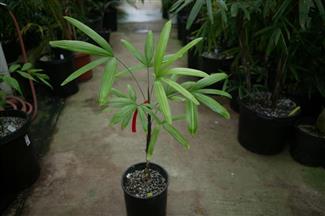
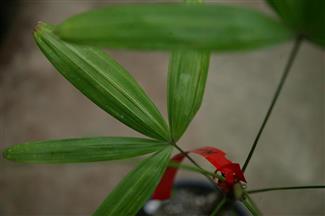
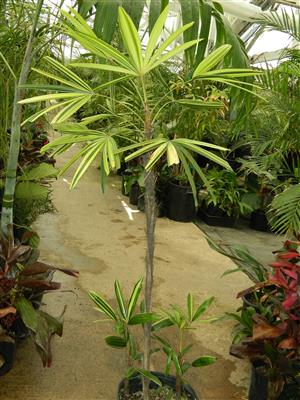
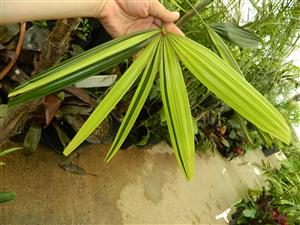

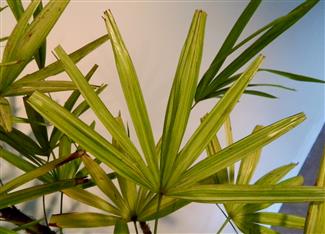
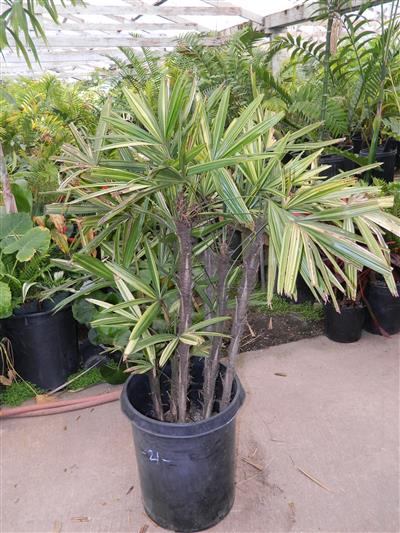
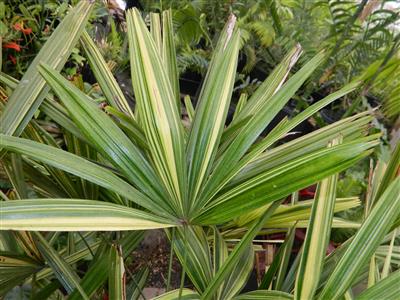
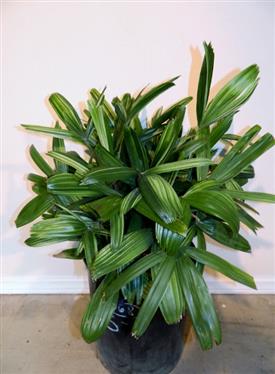
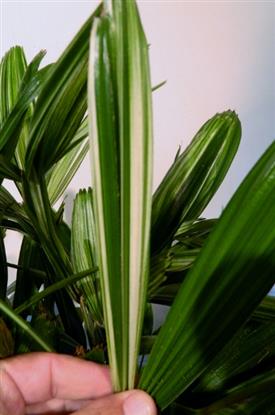
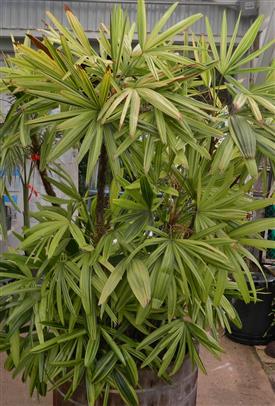
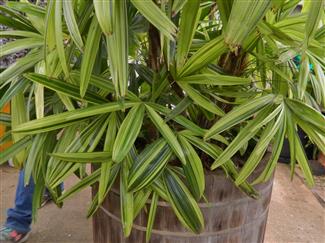
CULTURE OF VARIEGATED RHAPIS EXCELSA
Culture is not difficult with these variegated Rhapis palms. One can grow them inside the home with the right conditions. Or, outside in a patio or in the garden is fine. Most variegated Rhapis do not want much direct sunlight. Filtered light or a bit of morning sun would be best. They like sandy, good draining soils. We utilize a mixture of sand, peat moss, fine wood shavings, and perhaps a bit of topsoil and perlite. Water needs are about average. In hot weather they do need more water. Don’t let them dry out completely. Putting them into small pots does slow their growth. Cold tolerance is into the low 20’s F. In terms of fertilizer, beware! Too much nitrogen can make the yellow variegation disappear. And, Rhapis as a group are susceptible to fertilizer burn. So, go mild and not as often as you would on other types of palms.
PRUNING BROWN TIP LEAFLETS OF VARIEGATED RHAPIS
Variegated Lady Palms, like all types of Rhapis, can develop brown leaflet tips. This can be caused by low humidity, lack of water or by excessive fertilizer. Sometimes extremely hot weather can do it. But, these unattractive leaflets can be trimmed at their ends with a marked improvement in the plant’s appearance. We utilize a specialized scissor to cut the ends of the leaflets. See pictures below. This gives a more natural “chopped end” to the leaflets.
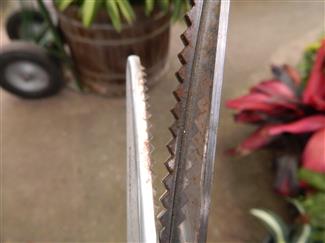
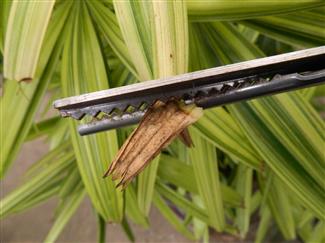
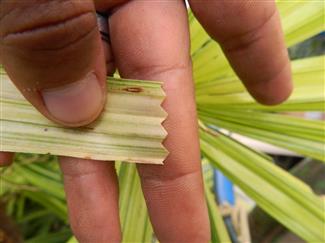
GROWING VARIEGATED RHAPIS PALMS FROM SEED
As Rhapis are a dioecous type of palm, remember, that to set seeds one needs a male and a female plant (2 plants, one each sex). So, this presents a problem. Also, when seeds are set, many times the seeds produced fail to produce variegated progeny. For these reasons, almost all nursery plants of variegated Rhapis are produced by what is called vegetative propagation. This means mother plants are either divided up into smaller, different plants. Or, an offset trunk is removed and propagated. But, if an enthusiast really want to work with seeds, it can be done. This would be particularly true with research hybridization. One would germinate seeds produced, cull out the green ones that don’t produce variegated leaves and work further with the ones that do. Hybridization of one named variety with another is what has been done in Japan to come up with new cultivars.
DIVISION OF LARGER VARIEGATED RHAPIS SPECIMENS
As mentioned above, vegetative propagation is the main way of producing new variegated Rhapis plants. From time to time at our nursery, we come across large, mature specimens of variegated Rhapis excelsa with many canes. Often such specimens has fifteen to twenty canes. We’d typically divide such a plant into four parts, basically into quarters as far as the root ball is concerned. We’ll inspect the ground surface of the root ball and make a plan as to where to cut the connecting subterranean trunks. It’s really not that complicated. Once these are cut, we work our way straight down into the root ball, separating the roots and trying to maintain the root balls of each quarter part. We try to get at least three to four good sized individual canes in each of the resulting divisions. We stay away from trying to propagate single stems. They do poorly and often succumb. Signs that your division was successful comes about a year later when you see new offsets forming at the base of the older mature canes. It will take five to ten years for those little offset suckers to get up to the mature height of the other stems.
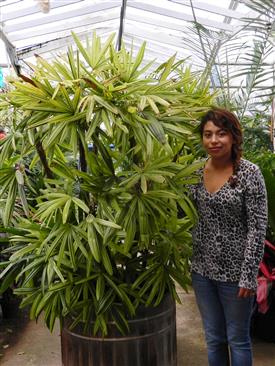
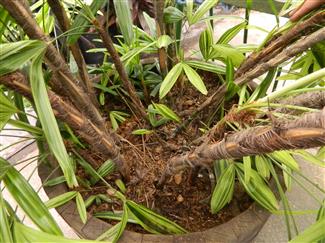

FURTHER READING ON VARIEGATED RHAPIS EXCELSA
There are very few references on variegated Rhapis palms. You might find a bit of information on the Internet. But, I know of only one book on the subject. And, any discussion of these plants would not be complete without a mention of this book, The Miniature Palms of Japan by Yoshihiro Okita and J. Leland Hollenberg. This smaller book deals only with variegated Rhapis and was published in 1981. It is the only written reference book I know of about the many cultivars on variegated Rhapis. The authors show examples of many cultivars and have a fairly good section on culture. Fortunately, at this time you can still find this book at a few botanical bookstores. Some photos are color, others in black and white.
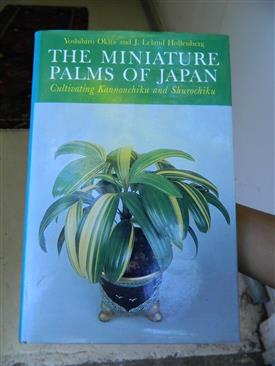
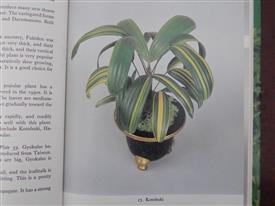
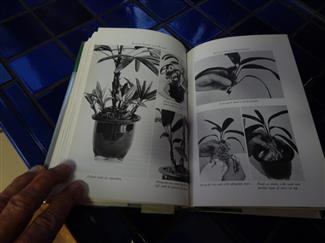
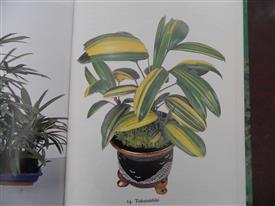

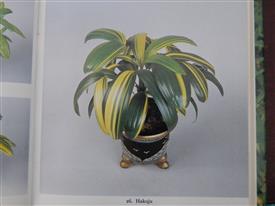
USAGE OF VARIEGATED RHAPIS IN THE HOME, GARDEN OR OFFICE
As you’ve read above, variegated Rhapis palms are used not only in the patio, home and garden but also in very upscale offices, especially in Japan. Some of the photos below are of plants that are adorned in the most expensive ceramic pots imaginable. These are often coveted and kept on top of an executive’s desk. But, don’t be intimidated by this. They are also great plants to add variety and color to the garden. Although never inexpensive, smaller plants are within the capability of most people’s budget. Across the board, they are mostly understory plants where they’d get filtered light. I wish to thank my old time friend, Lynn McKamey who previously had the unique specialty nursery, Rhapis Gardens, for her contribution of pictures.
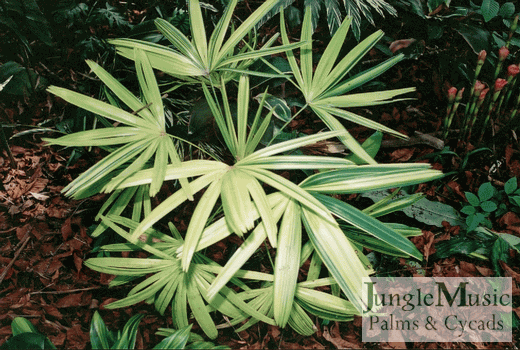
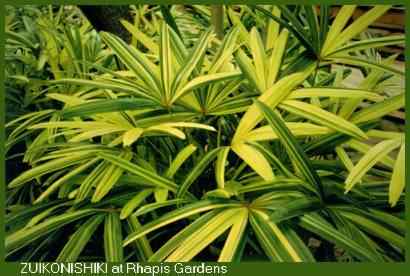

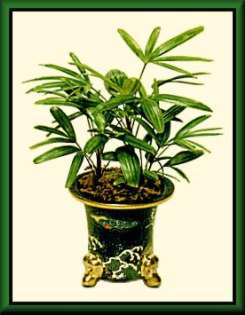
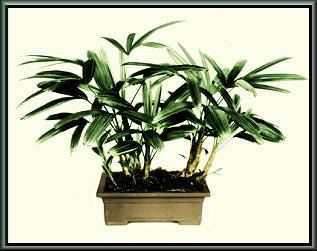
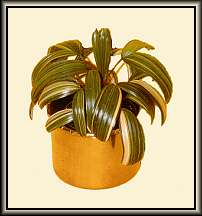
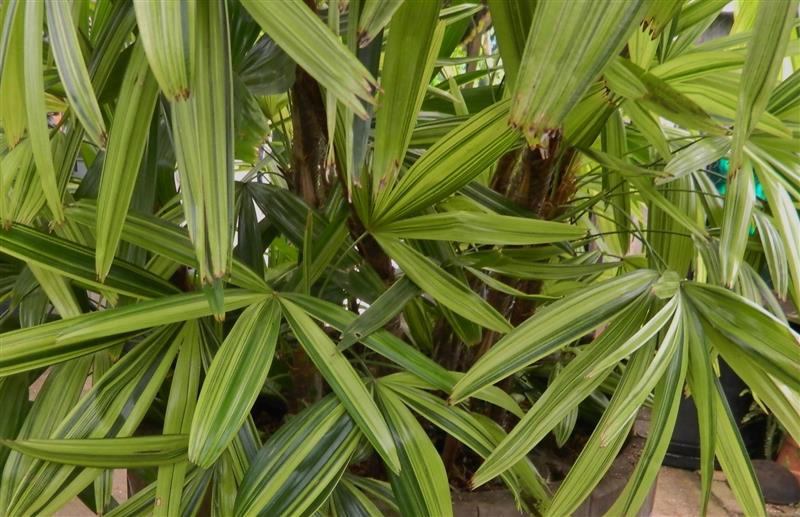
Thank you for reading this article about these amazing plants.
Contact me for any questions or inquiries.
We do have many variegated Rhapis for sale.
Phil Bergman
Jungle Music Palms, Cycads and Tropical Plants
- PALM TREES, CYCADS & TROPICAL PLANT BLOG - October 1, 2020
- TRACHYCARPUS
The Windmill Palm - September 30, 2020 - FAN PALMS –
PALMS WITH CIRCULAR LEAVES - September 29, 2020












